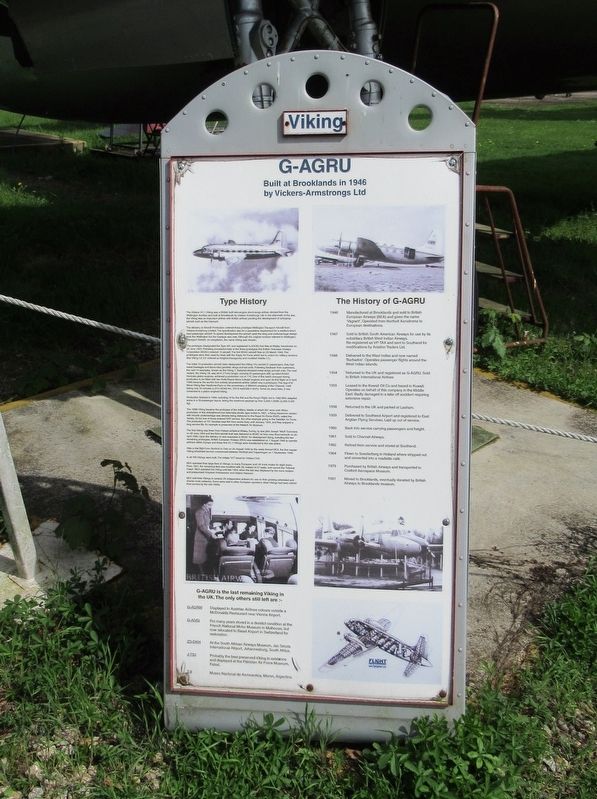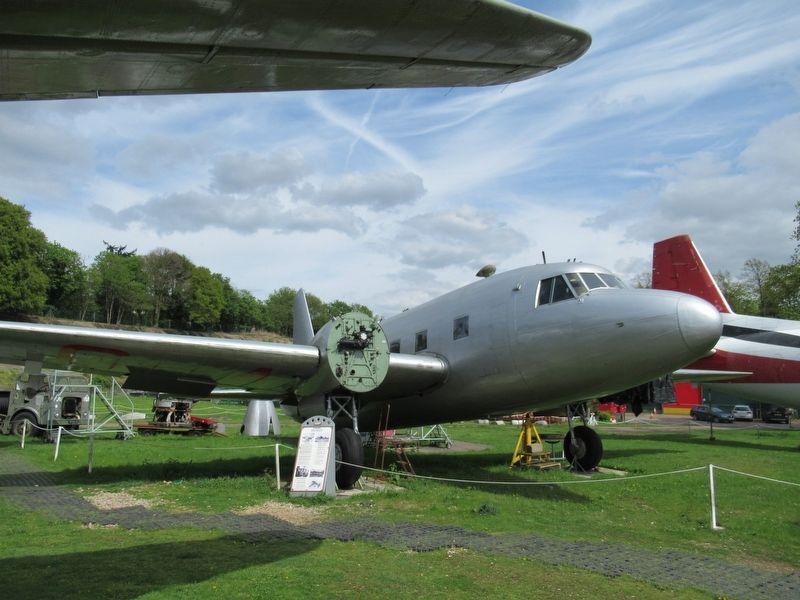Weybridge in Surrey, England, United Kingdom — Northwestern Europe (the British Isles)
G-AGRU
Built at Brooklands in 1946
by Vickers-Armstrongs Ltd
The Ministry of Aircraft Production ordered three prototype Wellington Transport Aircraft from Vickers-Armstrong Limited. The specification was for a peacetime requirement for a medium-short haul passenger aircraft. To speed development the aircraft used the wing and undercarriage design from the Wellington but the fuselage was new. Although the original contract referred to Wellington Transport Aircraft, on completion, the name Viking was chosen.
The prototype (designated the Type 491 and registered G-AGOK) first flew at Wisley Aerodrome on 22 June 1945. Following successful trials of the three prototypes the British Overseas Airways Corporation (BOAC) ordered 19 aircraft. The first BOAC aircraft flew on 23 March 1946. The prototypes were then used for trials with the Royal Air Force which led to orders for military versions (the Viking C2 (12 ordered as freighter/transports) and modified Valetta C1).
The initial 19 production aircraft (later designated the Viking 1A) carried 21 passengers, they had metal fuselages and fabric-clad geodetic wings and tail units. Following feedback from customers, the next 14 examples, known as the Viking 1, featured stressed-metal wings and tail units. The next variant, the Viking 1B, was 28 in (71cm) longer, carrying 24 passengers with up-rated Bristol Hercules piston engines, achieved a production run of 115. One of this batch changed during production to be fitted with two Rolls-Royce Nene turbojet engines and upon its first flight on 6 April 1948 became the world's first entirely jet-powered airliner (albeit only a prototype). The type 618 Nene-Viking flew Heathrow-Paris on the anniversary of Blériot's crossing of the Channel, 1948 taking only 34 minutes (c.210 mi/340 km, 370.6 mph 596.4 km/h). Some six years later, it was converted to a piston engined Viking.
Production finished in 1948, including 16 for the RAF and the King's Flight, but in 1952 BEA adapted some to a 38-passenger layout, taking the maximum payload up from 5,500-7,200lb (2,500-3,300kg). The 158th Viking became the prototype of the military Valetta of which 261 were sold. When production of this strengthened but externally-similar type ended in 1951, a flying classroom version with tricycle undercarriage was already being delivered to the Royal Air Force (RAF), called the Varsity, All but one of those entered RAF service the other example going to the Swedish Air Force. The production of 161 Varsities kept the Hum works busy until January 1954, and they enjoyed a long service life. An example is preserved at the Newark Air Museum.
The first Viking was flown from Vickers airfield at Wisley, Surrey, by test pilot Joseph "Mutt" Summers on 22 June 1945 and the third aircraft built was delivered to BOAC at Hum near Bournemouth on 20 April 1946. Upon the delivery of nine examples to BOAC for development flying, including the two remaining prototypes, British European Airways (BEA) was established on 1 August 1946 to operate airliners within Europe and these first VC.1 Vikings were transferred to the new airline.
After a trial flight from Northolt to Oslo on 20 August 1946 by the newly formed BEA, the first regular Viking scheduled service commenced between Northolt and Copenhagen on 1 September 1946.
In all 163 Vikings were built. The initials "VC" stood for Vickers Civil.
BEA operated their large fleet of Vikings on many European and UK trunk routes for eight years. From 1951, the remaining fleet was modified with 36, instead of 27 seats, and named the "Admiral Class". BEA operated the Viking until late 1954, when the last was displaced by the more modern and pressurized Airspeed Ambassador and Vickers Viscount.
BEA sold their Vikings to several UK independent airliners for use on their growing scheduled and charter route networks. Some were sold to other European operators. Most Vikings had been retired from service by the mid 1960s.
1947 Sold to British South American Airways for use by its subsidiary British West Indian Airways. Re-registered as VP-TAX and sent to Southend for modifications by Aviation Traders Ltd.
1948 delivered to the West Indies and now named ‘Barbados’. Operates passenger flights around the West Indian islands.
1954 Returned to the UK and registered as G-AGRU. Sold to British International Airlines.
1955 Leased to the Kuwait Oil Co and based in Kuwait. Operates on behalf of this company in the Middle East. Badly damaged in a take off accident requiring extensive repair.
1958 Returned to UK and parked at Lasham.
1959 Delivered to Southend Airport and registered to East Anglian Flying Services. Laid up out of Service.
1960 Back into service carrying passengers and freight.
1961 Sold to Channel Airways
1962 Retired from service and stored at Southend
1964 Flown to Soesterberg in Holland where stripped out and converted into a roadside café.
1979 Purchased by British Airways and transported to Cosford Aerospace Museum.
1991 Moved to Brooklands, eventually donated by British Airways to Brooklands Museum.
G-AGRU is the last remaining Viking in the UK. The only others still left are:
G-AGRW Displayed in Austrian Airlines colours outside a McDonalds Restaurant near Vienna Airport.
G-AIVG For many years stored in a derelict condition at the French National Motor Museum in Mulhouse, but now relocated to Basel Airport in Switzerland for restoration.
ZS-DKH At the South African Airways Museum, January Smuts International Airport, Johannesburg, South Africa.
J-750 Probably the best preserved Viking in existence and displayed at the Pakistan Air Force Museum, Faisal.
T-9 Museo Nacional de Aeronautica, Moron, Argentina.
Topics. This historical marker is listed in this topic list: Air & Space.
Location. 51° 21.371′ N, 0° 27.91′ W. Marker is in Weybridge, England, in Surrey. Marker can be reached from the intersection of Brooklands Road and Wellington Way, on the left when traveling south. Located at the Brooklands Museum. Touch for map. Marker is in this post office area: Weybridge, England KT13 0QN, United Kingdom. Touch for directions.
Other nearby markers. At least 8 other markers are within walking distance of this marker. Vickers 806 Viscount (within shouting distance of this marker); Vickers Merchantman (within shouting distance of this marker); Vickers Viscount 837 (within shouting distance of this marker); Jetstream T Mk. 1 (within shouting distance of this marker); BAC/Hunting Jet Provost (within shouting distance of this marker); Vickers 1103 VC-10 (about 90 meters away, measured in a direct line); BAC/Aerospatiale Concorde (about 90 meters away); Rolls-Royce/SNECMA Olympus 593 (about 90 meters away). Touch for a list and map of all markers in Weybridge.
Also see . . .
1. Vickers VC.1 Viking on Wikipedia. (Submitted on June 4, 2018, by Michael Herrick of Southbury, Connecticut.)
2. Brooklands Museum. (Submitted on June 4, 2018, by Michael Herrick of Southbury, Connecticut.)
3. Brooklands on Wikipedia. (Submitted on June 4, 2018, by Michael Herrick of Southbury, Connecticut.)
Credits. This page was last revised on January 27, 2022. It was originally submitted on June 4, 2018, by Michael Herrick of Southbury, Connecticut. This page has been viewed 374 times since then and 25 times this year. Photos: 1, 2. submitted on June 4, 2018, by Michael Herrick of Southbury, Connecticut.

